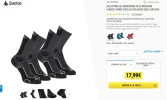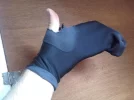D
Deleted member 67185
Guest
ArmaSkin socks came to my attention twice over the last month. The first time I read about them, I was mildly interested and I looked over the claims, researched a bit with the various subjective reviews on performance, and examined whether or not the claimed characteristics of the socks performance was consistent with the known facts for blistering and their prevention. but did no further follow up.
Early this morning, I read in a thread a post about ArmaSkins. My curiosity and backpacker's nerdiness then hit a peak, pushing me over the 'I need to see for myself' cliff. I am reposting what I wrote in that thread.
-----------------
ArmaSkin socks are a bit intriguing. They are intriguing because they rely on two methods to achieve what that which is needed in order to prevent blistering, or to at least prolong the time it takes for bistering to occur giving more time for someone to recognize a pre-blister 'hot spot' and take necessary action.
I have never tried them, but I have looked carefully at what the manufacturer claims will happen if you wear them and their theory of function, the materials and construction of the socks, and if the claims of blister prevention by the interruption of shear friction forces are plausible.
I ignore testimonials and other anecdotal observations, whether the anecdotes are positive or negative. After all, every blister prevention scheme ever concocted works for the believers who have had success with each method, and is a bitter failure to those who tried the same method but developed blisters anyway.
Bottom line for me: They hold promise, and I am going to purchase a pair for real world wear. I will be able to test the performance of each characteristic of the sock's construction as it contributes to blister prevention. The biggest factor I will be looking at is:
ArmaSkin socks are claimed to be able to wick moisture away from the feet. I will have to test that out to believe it, but I have no reason to doubt the claim based on the information of the sock's construction. Because ArmaSkins require an outer sock to work, I am going to look hard at whether or not my feet get too warm with the increased insulative effect. I normally use a lightly-padded, lightweight Merino wool sock.
I do reject the manufacturer's contention that the moisture wicking is an important factor in blister prevention. I look at this claim as feeding into the 'old hiker's tales' of failed theories. Although wicking moisture is good for foot hygiene and reduction of fungal growth, I view ArmaSock's focus on such as a blister prevention feature to be marketing hype, rather than science.
Wet skin does not promote shear force friction in and of itself. Having wet skin does not mean that blisters are inevitable or even likely. Wet conditions can soften the skin over time (maceration) and so can be more easily damaged by the effects of shear force friction which create blisters. However, if there is sheer force friction against the skin, it doesn't matter whether is wet OR dry, blisters will form. If the skin is wet, but there is no shear force from the sock to the skin, there should not be any blistering.
This will be an interesting test. I will have to get used to the change in the feel of using a double sock before I focus on the testing, as I don't want to have that new sensory input confusing or biasing the actual performance of the sock itself.
Are these socks a gimmick? I'll see for myself. A lot of people have used them and report that they work as advertised. There are very few negative reviews, but relatively speaking, this product has not seen a big user base. The primary negatives listed are that:
As a a backpacker who puts hundreds of miles covering rugged wilderness trails each year, I will be able to feel confident in my personal assessment on the suitability of the socks as an effective blister prevention strategy for myself -- and whether or not these socks provide a justifiable cost/benefit ratio compared to the current existing methods which are known to also be effective.
-------------------------------------
Early this morning, I read in a thread a post about ArmaSkins. My curiosity and backpacker's nerdiness then hit a peak, pushing me over the 'I need to see for myself' cliff. I am reposting what I wrote in that thread.
-----------------
ArmaSkin socks are a bit intriguing. They are intriguing because they rely on two methods to achieve what that which is needed in order to prevent blistering, or to at least prolong the time it takes for bistering to occur giving more time for someone to recognize a pre-blister 'hot spot' and take necessary action.
I have never tried them, but I have looked carefully at what the manufacturer claims will happen if you wear them and their theory of function, the materials and construction of the socks, and if the claims of blister prevention by the interruption of shear friction forces are plausible.
I ignore testimonials and other anecdotal observations, whether the anecdotes are positive or negative. After all, every blister prevention scheme ever concocted works for the believers who have had success with each method, and is a bitter failure to those who tried the same method but developed blisters anyway.
Bottom line for me: They hold promise, and I am going to purchase a pair for real world wear. I will be able to test the performance of each characteristic of the sock's construction as it contributes to blister prevention. The biggest factor I will be looking at is:
- The usable life span of the sock. Since there is a large number of variables which affect that measurement -- from the types of footwear and insoles used, to the weight of the wearer, to the number of steps it takes to cover a set distance from one individual to the next, etc -- my findings of this measurement cannot be an expected set standard for anyone else. But it will give a general indication of the friability of the sock in either the short or longer term.
- The repeat-ability of the sock's performance during the life span of the sock: does the sock perform at the end of its usable life as well as it did on the first day of wear?
- Providing a barrier to the skin from the effects of shear force friction. This is now done with tapes, moleskins, super glue and other coatings which harden on the skin after application, etc. ArmaSkin does this by a silicon coating which is slightly tacky, that is said to create a sort of 'gripping' stick to the skin quality to it which is designed to keep the sock immobile on the skin.
- Creating a shear force reaction which is directed away from the sock to the skin, and places it between the shoe and the sock. ArmaSkin do this by sizing the sock to be a snug fit allowing the outer material of the sock to slide over the the interior of the shoe. That is now done by making sure that the socks, any socks, that are used for hiking are sized to be snug -- not tourniquet tight -- on the foot.
ArmaSkin socks are claimed to be able to wick moisture away from the feet. I will have to test that out to believe it, but I have no reason to doubt the claim based on the information of the sock's construction. Because ArmaSkins require an outer sock to work, I am going to look hard at whether or not my feet get too warm with the increased insulative effect. I normally use a lightly-padded, lightweight Merino wool sock.
I do reject the manufacturer's contention that the moisture wicking is an important factor in blister prevention. I look at this claim as feeding into the 'old hiker's tales' of failed theories. Although wicking moisture is good for foot hygiene and reduction of fungal growth, I view ArmaSock's focus on such as a blister prevention feature to be marketing hype, rather than science.
Wet skin does not promote shear force friction in and of itself. Having wet skin does not mean that blisters are inevitable or even likely. Wet conditions can soften the skin over time (maceration) and so can be more easily damaged by the effects of shear force friction which create blisters. However, if there is sheer force friction against the skin, it doesn't matter whether is wet OR dry, blisters will form. If the skin is wet, but there is no shear force from the sock to the skin, there should not be any blistering.
This will be an interesting test. I will have to get used to the change in the feel of using a double sock before I focus on the testing, as I don't want to have that new sensory input confusing or biasing the actual performance of the sock itself.
Are these socks a gimmick? I'll see for myself. A lot of people have used them and report that they work as advertised. There are very few negative reviews, but relatively speaking, this product has not seen a big user base. The primary negatives listed are that:
- The stated sizes recommended are extremely tight and needed to buy a bigger size.
- The socks are a bit difficult to put on.
- Cost. I am purchasing two pairs through Amazon. Shipping is free. The cost for the two pair is about $70.00

 I am buying one pair in the size recommended by the ArmaSkin size chart; and I am buying one pair, different color, one size larger. I will return the one which fits the least well.
I am buying one pair in the size recommended by the ArmaSkin size chart; and I am buying one pair, different color, one size larger. I will return the one which fits the least well.
As a a backpacker who puts hundreds of miles covering rugged wilderness trails each year, I will be able to feel confident in my personal assessment on the suitability of the socks as an effective blister prevention strategy for myself -- and whether or not these socks provide a justifiable cost/benefit ratio compared to the current existing methods which are known to also be effective.
-------------------------------------






















